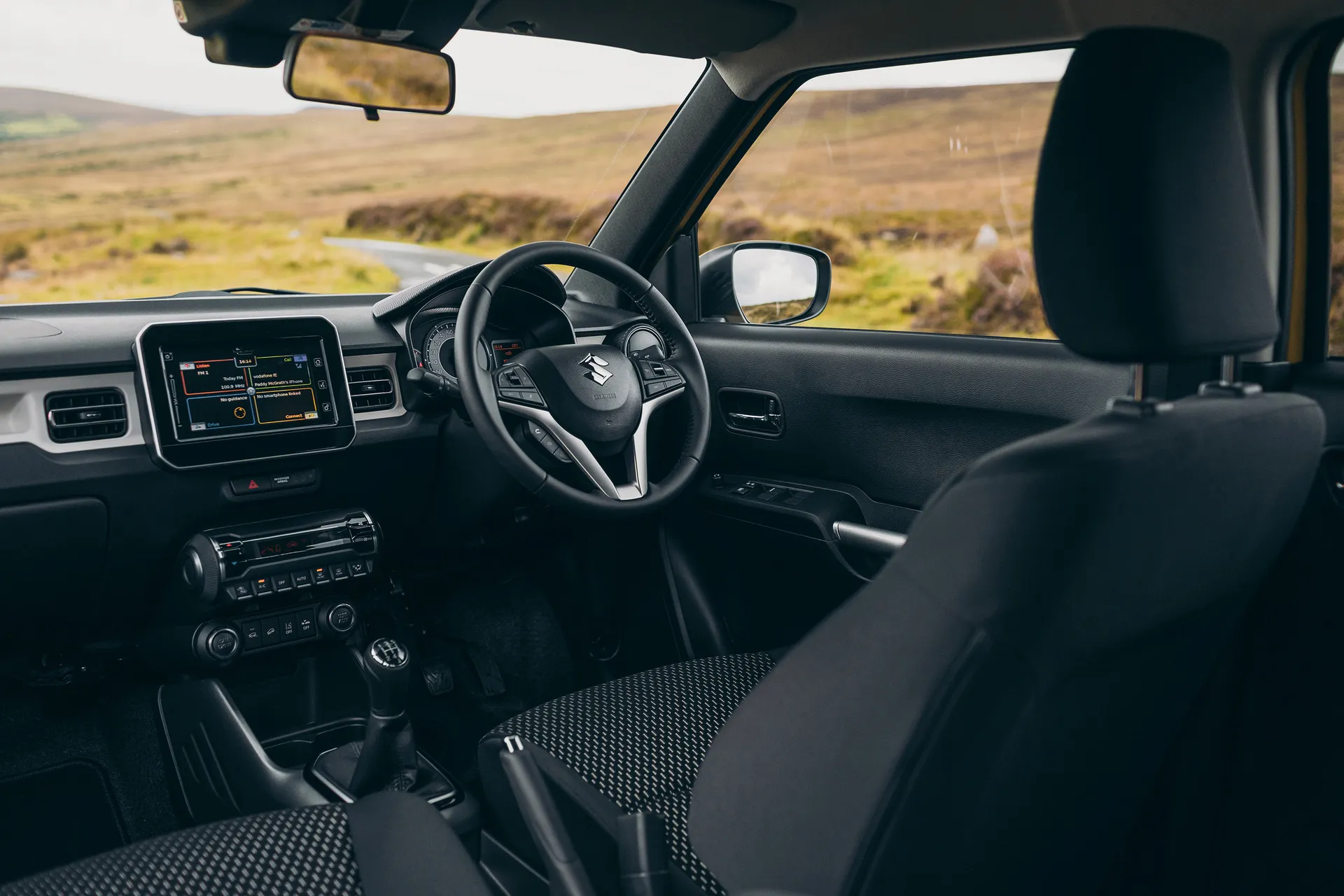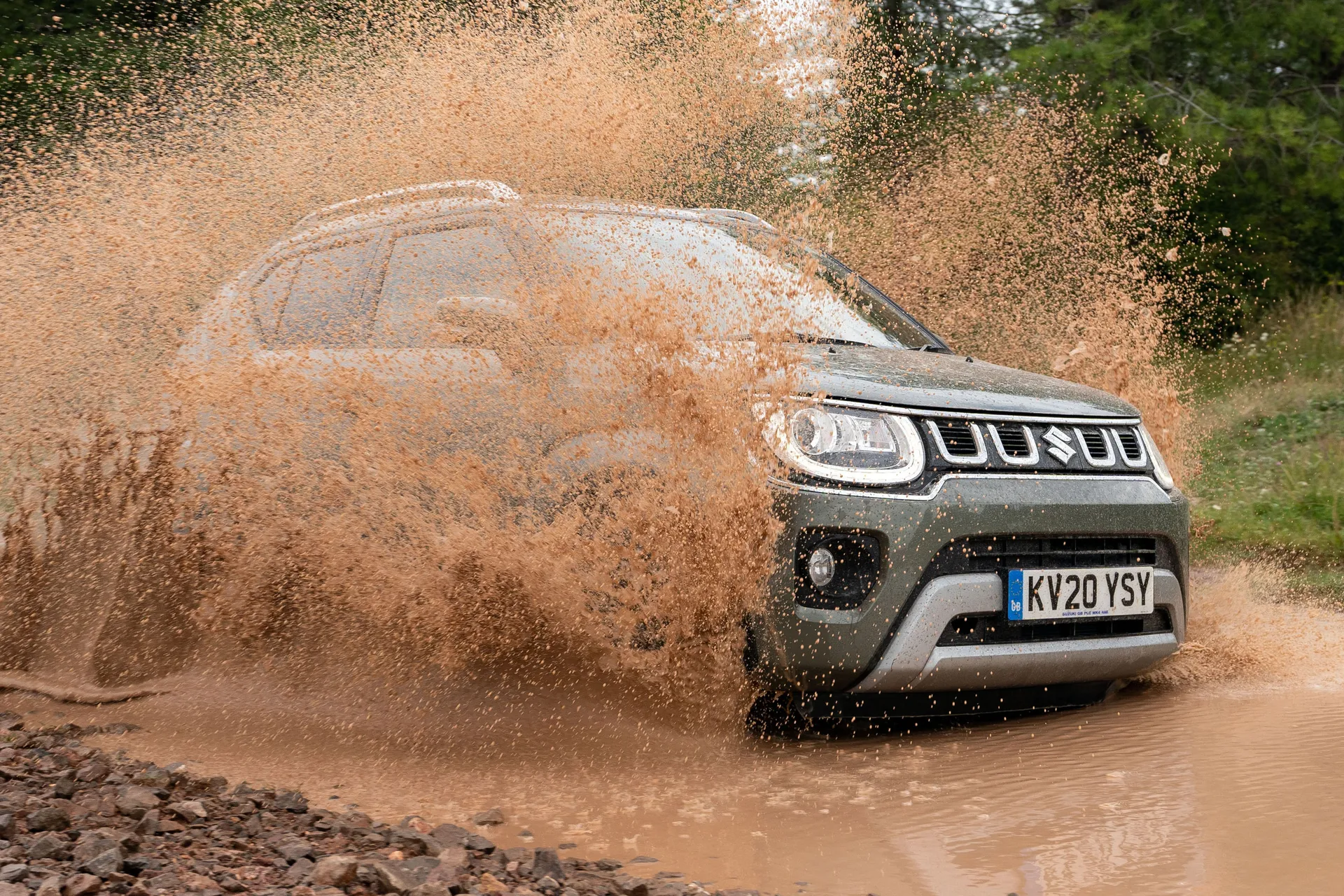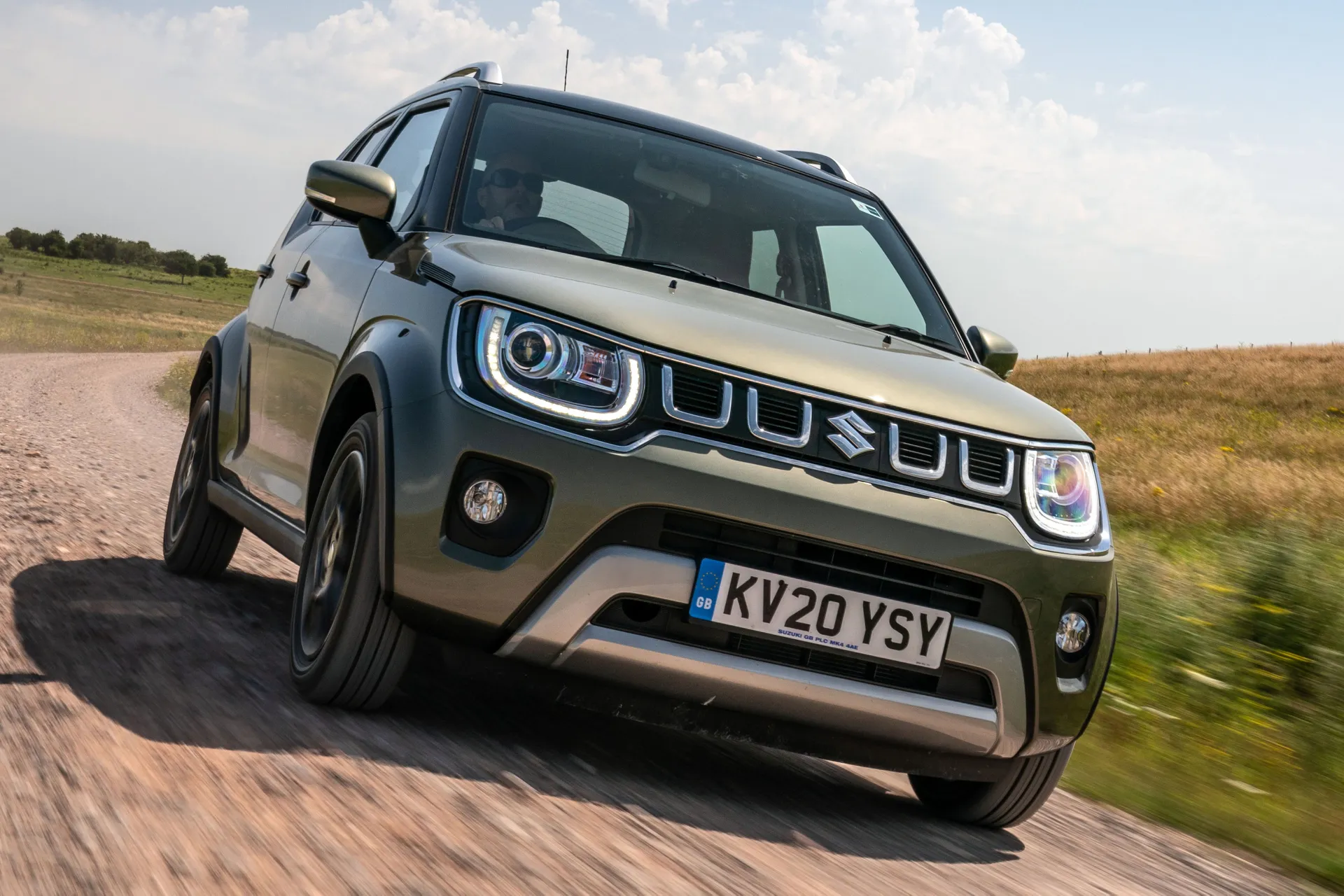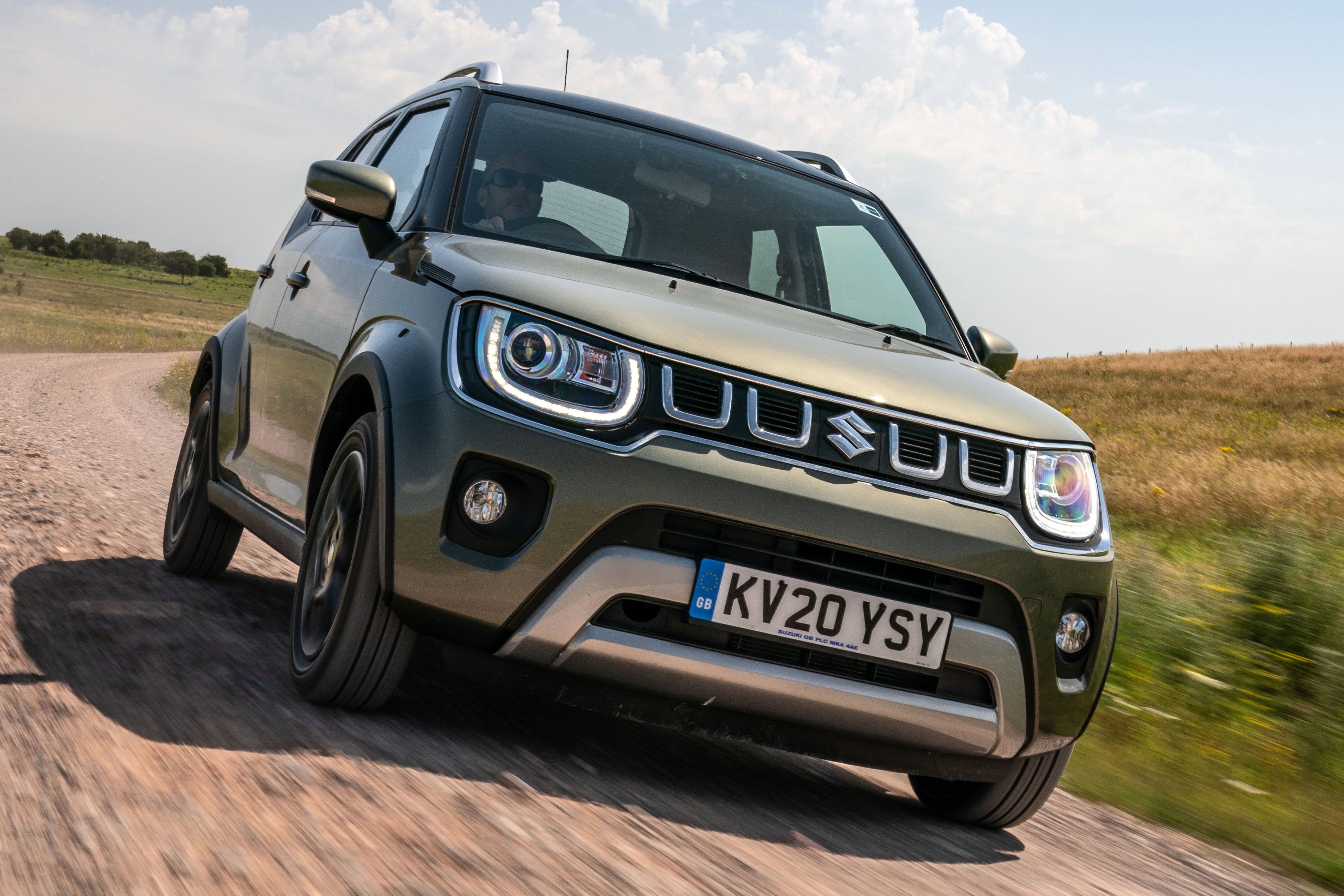Suzuki Ignis (2017-2025) Review
Written by Andrew Brady
Quick overview
Pros
- Interesting design inside and out
- Low running costs
- Good standard specification
Cons
- Some cheap-feeling interior elements
- Top models expensive
- Ride upset by some surfaces
Verdict: Is the Suzuki Ignis a good car?
"There’s a lot to like about the Ignis, not least because it’s something a bit different. It looks great, is well specified, decent to drive and should be cheap to run, too. It’s not as classy or as nicely finished as some rivals and gets expensive if you choose the wrong spec, but it’s a good choice if you don’t want to follow the herd."

In this Suzuki Ignis review, you'll discover that Suzuki is a brand that has concentrated on smaller cars in recent years, and enjoyed a good deal of success, with the excellent Swift in particular.
In the city car class, it previously offered the Celerio, which majored on value and equipment but lacked much in the way of style or driver appeal. Suzuki took a different approach with the introduction of the Ignis, which is somewhere between a city car and a crossover SUV.
The dimensions certainly qualify it for the city car class. Being exactly 3.7 metres long it is just 10 centimetres longer than a Volkswagen Up, and at 1.7 metres wide, it’s certainly narrow. Where the Suzuki Ignis differs from pretty much every other city car in the class is in its height. It might be more of a crossover than a proper SUV, but it gives the kind of upright stance and improved view out that makes this type of car so appealing to buyers.
The Ignis also makes a much stronger style statement than the more conventional Celerio, and taps into the current fashion for SUVs with its chunky styling, higher-than-average ride height and bold detailing. More importantly, however, the Ignis actually offers SUV-like space, at least for a car of this size anyway. Thanks to the tall body, it can fit four adults with ease and comfort, and the boot space is right up with the best in class.
The engine options for the Ignis are straightforward: there’s a single 1.2-litre, four-cylinder petrol engine with 83PS and 107Nm of torque, and it has Dualjet technology that has two injectors per engine cylinder for maximum efficiency. Initially, Suzuki offered it either with or without SHVS, a mild hybrid system that harvests lost energy under braking and uses it to boost acceleration at low speeds for better performance and enhanced fuel economy. Later on, all versions got the system, and if you liked, you could specify it with a CVT automatic gearbox or four-wheel drive (but not both).
On the inside, the Ignis provides an impressive amount of space for a car of this size. The tall body comes to the forefront here, as it means excellent headroom for both front- and rear-seat passengers. Legroom isn’t quite as generous in the back, but this is a small car that can take four adults comfortably.
To drive, the Ignis is relatively good fun, if not exactly flawless. Most importantly it’s great in town, where its compact dimensions and light weight make it highly manoeuvrable and easy to park. The ride quality is good in most conditions, too, with a suspension setup designed primarily with comfort in mind. Occasionally it is caught out by sharper bumps, but it’s as good as key rivals in this respect.
The Ignis puts a kooky spin on the city car formula, and although its SUV-like approach won’t suit everyone, it will also attract buyers who fall for its unusual charms and don’t want any of the more conventional alternatives.
Looking for a used car for sale? We've got 100s of Suzuki Approved Used Cars for Sale for you to choose from, including a wide range of Suzuki Ignis models for sale.
Is the Suzuki Ignis right for you?
The Ignis is as capable in the city as anything else in the class, and with its generous passenger space it is a sensible choice if you need a small car that can regularly carry four people. It also has an extra string to its bow with the option of four-wheel-drive, although this means it can tackle a muddy field rather than traverse the Alps. It’s also an appealing choice for new drivers, with distinctive looks and a strong standard specification.
If you regularly plan to travel long distances or hit the motorway frequently, you might want to choose an alternative with a bit more refinement, however, and if you want a city car that’s as good to drive as it is to look at, you probably need to take a look at one of the Up/Citigo/Mii triplets from the Volkswagen Group.
What other cars are similar to the Suzuki Ignis?
Because the Ignis is something of an oddball in this sector there are few cars that really qualify as direct rivals. The previous Fiat Panda was available as a Panda 4x4 and cost similar money, and although it’s a good car, it’s feeling its age and is quite cramped inside.
Of the more mainstream alternatives, the Toyota Aygo, Peugeot 108 and Citroen C1 are big on value and equipment, while the Skoda Citigo, SEAT Mii and Volkswagen Up are classier alternatives.
Comfort and design: Suzuki Ignis interior
"Just like the Suzuki Celerio, an older stablemate of the Ignis, a high body is a real bonus when getting in or out of a car."

Like bigger SUVs, a slightly raised seating position and a taller roof mean you don’t have so far to duck down to get into the seat, which is good news however old you might be. Once in the driver’s seat there is a good amount of adjustment for the steering wheel and seat, although the basic SZ3 model doesn’t have height adjustment for the driver. Like almost every city car, there’s no reach adjustment for the steering wheel, either.
The seats themselves offer a reasonable level of comfort for most shapes and sizes, although in terms of support they are a little lacking. There’s not much in the way of side bolstering, so anything approaching enthusiastic cornering will get you siding around in your seat.
Another plus point of the squared-off design and SUV-light approach is a good view out for the driver. The windscreen is generously sized, and although the rising window line towards the rear does cut down your over-the-shoulder view a little, the car's compact dimensions means it’s easy to judge where everything is when it comes to parking up.
The layout of the cabin is also refreshingly straightforward, with the audio system (depending on specification) set high up on the dashboard, and ventilation and minor controls set below.
Quality and finish
Climb into the cabin of the Ignis and the initial impressions are good. It looks pretty smart, with a two-tone finish to the dashboard that feels like a step above the usual uniform grey finish. SZ-T and SZ5 models look particularly swish, with a touchscreen infotainment system that gives off quality vibes.
Get a bit closer, however, and it becomes clear that the materials aren’t quite as fancy as they first appear. Although the steering wheel and gear lever are leather-wrapped on SZ-T models and above, most of the materials are actually quite hard to the touch and do not feel particularly substantial, which takes some of the shine off the interior.
Suzukis generally offers a good standard of build quality and reliability, and although the Ignis appears to be well-built, the fact that some of the cabin materials are a little flimsy and cheap-feeling suggests they might not last as well as you would hope.
Infotainment: Touchscreen, USB, nav and stereo in the Suzuki Ignis
The entry-level SZ3 Ignis has a rather basic infotainment system, which includes an FM/AM radio with DAB and a USB input, as well as Bluetooth for phone connectivity and audio streaming. Move up to the SZ-T or SZ4 models and this is upgraded to a 6.2-inch touchscreen system that includes both Apple CarPlay and Android Auto as well as Bluetooth, with additional controls on the steering wheel for the major functions.
In the SZ3, the system has an old-fashioned digital display, which can make flicking through DAB stations or streamed music a bit of a faff, although having physical buttons to press can also be the better option at times.
The touchscreen system looks quite fancy but can be fiddly to use on occasion. Pair it up to your smartphone and it works well enough, replicating the functions of your phone and being easy to control. If you use the system’s internal functions, however, including the sat nav, it’s less impressive, with the occasional lack of response when you tap the screen and a mediocre screen resolution. Even so, once you’ve actually got the system doing what you want, whether that’s playing audio or connecting to your phone, it works well enough, so while it might occasionally frustrate it does still provide the functions it promises.
Space and practicality: Suzuki Ignis boot space
This isn’t the first car Suzuki has made in the city car class, and like its predecessors, the Ignis makes the most of its footprint on the road by building upwards. All city cars are up against the same conflicting need to be small on the road and big inside, and the Ignis does a good job on both fronts. Up front, adults of all sizes should find there is enough head- and legroom, even if the lack of reach adjustment on the steering wheel means the tallest drivers may find their view of the instruments slightly hampered.
It’s also impressive in the rear, with enough space for adults to travel in reasonable comfort. If you go for the SZ3 model you get bench rear seat that has three seat belts, although it'll be one heck of a squeeze to get three normal-sized adults across the back. SZ-T and SZ4s have a more sensible option, with a rear seat designed for two with a pair of seat belts, and the option to slide them forwards or backwards to increase the amount of legroom or boot space. Taller adults may start to feel a little cramped, but it is a realistic prospect to travel four-up on a regular basis.
The Suzuki Ignis boot space is a handy 260 litres with the rear seats in place, a little more than most of its rivals. That increases to 514 litres when you fold the rear seats, which is quite a bit less than the competition, and the design of those seats means they don’t fold completely flat. It’s also worth noting that should you go for the AllGrip four-wheel-drive version, the boot is smaller by 60 litres because of the extra hardware required.
Storage space in the cabin is good, though, with reasonably-sized door pockets that can hold a water bottle, four cupholders dotted around the cabin, and a glovebox that can hold more than just a pair of gloves.
In terms of its actual size, the Suzuki Ignis' dimensions are 3700mm long, 1690mm wide and 1605mm tall.
Handling and ride quality: What is the Suzuki Ignis like to drive?
"It might be hard to take the Ignis seriously as an SUV, but take a drive in one and you can see that it’s more than just a visual thing."

With a relatively soft suspension setup, the Ignis is clearly designed to deal with poor road surfaces as a priority, and on this front it does a good job most of the time. It manages to filter out most grainy urban road surfaces, but the Ignis struggles to cope with the occasional bigger imperfection, resulting in a noticeable thud resonating through the cabin. For the most part, however, the Ignis is in contention with the most comfortable cars in the segment.
With quite a tall body and that soft suspension, it should come as no surprise to discover that the Ignis leans quite a bit when you start to corner at speed. Not alarmingly so, and there’s never any fear it’s going to turn turtle, but it does still feel a bit top-heavy and clumsy. Matters aren’t helped by the steering, which is accurate and plenty quick enough, but lacks any real feel.
That said, there’s still fun to be had in punting the Ignis around simply because it is so short, light and happy to change direction. There’s also plenty of grip.
If you have designs on the AllGrip version being some kind of cut-price Land Rover, then you'll be disappointed, but even so, it's more capable in the sticky stuff than many will be expecting. Muddy fields and the odd slope can be dispatched fairly easily.
What engines and gearboxes are available in the Suzuki Ignis?
The Ignis’s 1.2-litre engine almost seems a little old-hat now as it does without a turbocharger, but in fact Suzuki is a little ahead of the curve by using other methods to boost the performance and efficiency of its engines.
The 1.2-litre unit has Dualjet technology, which in simple terms means it has a pair of fuel injectors per cylinder instead of the usual one, allowing more precise control of combustion and increasing efficiency. The other option is called SHVS, which is a mild hybrid system. It harvests energy that would otherwise be lost during braking and stores it in a small battery pack, and this energy is then used during acceleration to boost torque levels. Mild hybrid means it is a system with limited power, not enough to drive the car on battery power alone, but it does increase performance without using any additional fuel. Initially, you could have your Ignis either with or without the SHVS system, but later examples all have it as standard.
Both engines offer genuinely useful performance. No one expects a car of this size to be rapid, but there is useful acceleration available without having to thrash the engine from a standstill. As for choosing between the two units, the mild hybrid does offer slightly improved acceleration and better fuel consumption, but did cost more than £1,000 extra when buying new, and used versions will have a proportional deficit.
The standard five-speed gearbox is an able companion, too, with a positive shift action that is accurate and easy to use. Suzuki also offered the Ignis with a five-speed automated manual gearshift, or later on a CVT (Continuously Variable Transmission) automatic. Unless you really need an auto, we’d stick with the regular manual in both cases.
Refinement and noise levels
Thanks in part to the modern engine design, the Ignis offers competitive levels of refinement, even at higher speeds. In town the engine is audible but never intrusive, and even at higher speeds it is usually a background thrum rather than anything more significant or bothersome. In fact, the engine has a pleasing, eager sound to it.
Road noise is also largely kept in check, regardless of how fast you’re going. In town you’ll not notice any kind of hum coming from the tyres, largely due to the fact that they are quite narrow in profile. Get up to speed on dual carriageways and motorways, and the volume increases.
More of a factor is wind noise, which is a downside of the Ignis’s bulky and bluff design. Once again, low speeds are not much of a problem, but at out-of-town speeds you can hear the wind whipping around the windscreen and the door mirrors, with the only solution to slow down. Overall, the Ignis is a little less refined than the better cars in the class, but this only really becomes an issue at higher speeds.
Safety equipment: how safe is the Suzuki Ignis?
Euro NCAP tested the Ignis when it was launched in 2017, and was awarded two scores depending on the level of equipment. The standard version scored three stars overall, with an adult occupant score of 79 per cent, child occupant score of 79 per cent, a pedestrian mitigation score of 67 per cent and a low safety assist score of just 25 per cent.
The version with the safety pack, which adds automatic emergency braking among other features, scored 87 per cent for adult protection, 79 per cent for child protection, 77 per cent pedestrian mitigation and a much-improved 60 per cent for safety assist. That meant a five-star rating overall. However, both scores are now expired, because Euro NCAP states that ratings are only valid for a five-year period due to ever-increasing safety standards.
As standard, all Ignis models are fitted with six airbags - driver and passenger plus side and curtain airbags - but there is no knee airbag for driver or passenger. There are two Isofix points in the rear seats, plus seatbelt pre-tensioners and load-limiters for front seat passengers.
ESC is standard on all models, while the safety pack is standard on the top SZ5 models but optional on the rest of the range. It includes automatic emergency braking, including pedestrian detection, a speed limiter and lane departure warning, and to achieve the five star Euro NCAP rating this pack is required. Go for the AllGrip option and the Ignis also comes with hill descent control, which is a useful additional feature if you regularly need to travel off-road.
MPG and fuel costs: What does a Suzuki Ignis cost to run?
"Both versions of the Ignis should be cheap to run, thanks to a combination of light weight and modern, efficient engines. Both versions of the Ignis have the same combined fuel consumption and CO2 figures under WLTP rules: 51.4mpg and 117g/km of CO2."

However, with the hybrid version offering additional torque it should deliver better MPG in the real world than the non-hybrid version, but you’re guaranteed a saving if you don’t pay the extra in the first place.
Suzuki Ignis reliability and warranty
You can expect the Suzuki Ignis to be very reliable. In the latest HonestJohn.co.uk Satisfaction Index, Suzuki was ranked sixth (out of 33 carmakers) in our list of the most reliable car manufacturers. All Suzukis come with a three-year/60,000-mile warranty to begin with, but if you have your car serviced according to schedule at a Suzuki main dealer, then you get an additional year of warranty cover up to a maximum of ten years or 100,000 miles, whichever comes soonest.
Suzuki Ignis insurance groups and costs
One area where the Ignis falls down compared to much of the competition is in car insurance costs. Even the cheapest versions of the Ignis sit in group 15, and can go as high as 21 if you choose the wrong spec. Many of its city car rivals are comfortably ten groups lower, so if you are in a demographic that has to endure high insurance premiums, the Ignis is going to cost you extra for the privilege. It may well also make it unsuitable as a car for newly-qualified drivers.
VED car tax: What is the annual road tax on a Suzuki Ignis?
The very earliest versions of the Ignis will have been registered just before the rules changed for VED in April 2017, and the 100g/km CO2 threshold became less meaningful. So, if you manage to track down one of these early cars, you can have an annual VED bill that is just £20 or even zero. However, most cars will have been registered after this date, and so will pay the same flat rate applied to all more modern vehicles. Expect to pay £195 per year.
Suzuki Ignis price
"The Ignis is no longer on sale as a brand new car, so if you want one, your only option is to turn to the used car market."

That's a good thing, though, because there are some very tempting deals to be had. Browse our classifieds, and you'll find the cheapest examples clocking in at around £7,000. These are early examples, mainly with the non-mild-hybrid powertrain, but some mild hybrids are available at this money. Most examples are of desirable SZ-T and SZ-5 spec, too. The big variable here is the mileages of these examples: the higher the spec of the cars at this money, the higher the mileage will be, and the range sits at anywhere between 30,000 and 80,000.
If you fancy something a bit fresher, around £15,000 should get you a year-old SZ-T mild hybrid with less than 5,000 miles on the clock.
Trim levels and standard equipment
There’s no shame in choosing the basic SZ3 trim for the Ignis. It includes the basic essentials such as air con, but also a few more of the useful extras like Bluetooth, DAB and daytime running lights.
The pick of the range, however, is the SZ-T model, which introduces the touchscreen infotainment system: no, it’s not perfect, but crucially it adds Apple CarPlay and Android Auto, which is a must-have for modern drivers. It also includes the sliding rear seat, which for most people will be more useful than the three-seat rear bench on the SZ3.
The SZ5 comes with more goodies, but looks expensive compared to the rest of the range, and compared to rivals.
Ask the heycar experts: common questions
Is the Suzuki Ignis a good car?
Is the Suzuki Ignis worth buying?
Is the Suzuki Ignis good for long journeys?
Get our latest advice, news and offers
Keep me updated by email with the latest advice, news and offers from heycar.
By submitting you agree to our privacy policy



